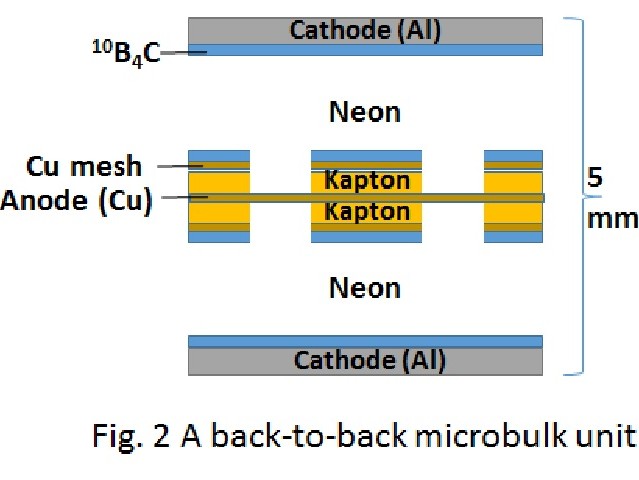Micromegas Detectors
A micromegas detector consists of parallel anode and cathode plates with a metallic nickel micromesh that divides the gas gap between them into two: a drift region where ionization occurs and an amplification region. First designs involved mounting the mesh to spacers attached to the anode; this is the bulk Micromegas. Problems in the construction process of this detector has led to the development of microbulk Micromegas designs that use etching techniques to create an integrated anode-mesh structure. Bulk is robust, cheap, easy to operate and suitable for making large area detectors. Microbulk will provide better gap definition and an easier construction process. Great news for designing new detectors for neutron sources! A microbulk Micromegas detector uses a thin flexible polyimide material called Kapton covered on each side with a thin layer of copper metal. This is fixed to a rigid material that incorporates the anodes. The unwanted copper and Kapton is removed through chemical etching techniques to leave a copper micromesh supported by Kapton pillars. The mesh size is about 40μm. To make the detector neutron sensitive, a neutron converter is included. SINE2020 researchers at CEA are investigating the deposition of solid 10B4C on to the mesh and cathode to double conversion opportunities. According to simulations, a back-to-back microbulk detector design with a thickness of 5mm could be 17% efficient. These microbulk designs do not contain circuit boards (PCB) and have very small pillars that support the readout components and micromesh, thus reducing “dead space” within the detector and reducing unwanted neutron scattering making it possible to stack several layers to improve detection efficiency. This is a promising design for development of neutron technologies. The team at CEA found simulations predict that four back-to-back units could achieve 40% efficiency at 1.8Å and, at a 45˚ tilt with respect to the neutron beam, could even reach 45% for 2µm thick 10B4C layers. Unfortunately, the scientists encountered problems with B4C peeling off the microbulk material. Investigations into understanding why this is occurring are continuing. A prototype of bulk Micromegas has been built: it consists of a [15 × 15 × 2]cm3 chamber where 4 Nickel micromeshes can be stacked. Testing with 2 Nickel micromeshes covered in B4C on both sides (5 layers in total) in an He-CO2 gas mixture led to a detection efficiency of around 18%. Using GEM foils The team are also investigating the inclusion of Gas Electron Multipliers (GEM) foils in the detector. A GEM foil consists of Kapton material clad in copper metal layers and covered by nickel on both sides to try to improve B4C adhesion. It has conical holes etched into it sized about 40μm and spaced out every 40μm. When electrons drift into the holes they are amplified efficiently. Using GEM foils could provide significantly higher electron transmission because of this. They are also cheap and robust so they could be used for large surfaces. Initially, the team verified simulations using a version where only the cathode was boron-coated. The GEM foil was positioned between the electrodes dividing the drift region into two 2mm gaps. The experimental results compared well with the simulation results. A prototype was also tested that consists of a double boron-coated nickel mesh and a GEM foil positioned below it to improve the electron transmission as the electrons move to the anode. Results are promising. In an ideal set-up the GEM foil itself would be boron-coated. Unfortunately, the scientists have encountered problems when coating the GEM foil - it has not functioned afterwards. Now the team are exploring coating the GEM foil with just 10B instead.
Keywords
Countries
France



